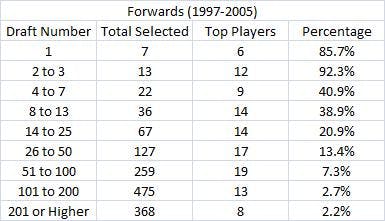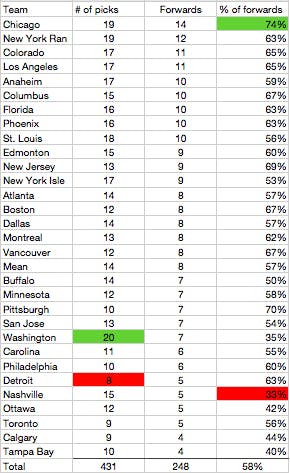The Flames and Organizational Depth
By Kent Wilson
13 years agoTLP’s draft post and contributing to Hockey’s Future has made it mainfestly obvious to me just how shallow the Flames are at forward. Even with guys like Howse, Wahl, Nemisz and Backlund in the picture, Calgary lags well behind even the median NHL team in terms of skilled, viable youngsters up front.
That dearth of talent is is a big, black void staring Flames fans in the face this off-season. With zero choices inside the first two rounds, a lack of cap space and a club built mostly around expensive but depreciating assets up front, it’s likely a number of folks are looking around and wondering how the team has gotten to this point.
I used a recent post by Scott Reynolds for a basis of this investigation. He recently looked at drafts between 1997 and 2005 to determine the rate at which teams were able to find effective players at various positions. We’ll focus on his findings at forward for the purposes of this article.
 At left are the results. Reynolds chose his criteria to be any forward who has played a minimum of 200 NHL games and has scored a minimum of 0.5 points per game. Which makes the cut-off point an everday NHLer who can contribute about 40 points over the season. This excludes replacement level guys and goons, which strikes me as sensible.
At left are the results. Reynolds chose his criteria to be any forward who has played a minimum of 200 NHL games and has scored a minimum of 0.5 points per game. Which makes the cut-off point an everday NHLer who can contribute about 40 points over the season. This excludes replacement level guys and goons, which strikes me as sensible.As you can see, the talent goes quickly. By the time you reach the last third of the first round, your chances of grabbing a 40 point forward drop from 9 in 10 inside the top 3 to just 1 in 5. Things fall off a cliff after the top 60 and you’re basically into lottery ticket territory past 100.
Glancing at this graph, the Flames issue becomes obvious to anyone remotely familiar with the clubs drafting record under Darryl Sutter. Since 2003, the Flames have had just 9 choices inside the top 60: Dion Phaneuf, Tim Ramholt, Kris Chucko, Matt Pelech, Leland Irving, Greg Nemisz, Mitch Wahl, Mikael Backlund and Tim Erixon. Only four of Calgary’s top 60 picks have been forwards (Chucko, Nemisz, Wahl and Backlund) and none of them have been higher than #24 (or, a 21% shot a 40 point forward).
To add some context to those numbers, I went through each draft since Sutter took over to determine how other teams were picking over that span:
 The chart shows the total number of picks by each team inside the top 60 since 2003, as well as the number of forwards taken with those picks. The data is arranged from most to least forwards chosen over that period. Also, the "% of forwards" column shows the rate at which each club used their top two round picks to choose forwards. Green and red squares mark the most and least in each category respectively.
The chart shows the total number of picks by each team inside the top 60 since 2003, as well as the number of forwards taken with those picks. The data is arranged from most to least forwards chosen over that period. Also, the "% of forwards" column shows the rate at which each club used their top two round picks to choose forwards. Green and red squares mark the most and least in each category respectively. The Flames are tied for the least amount of forwards chosen with top 60 picks in the league since 2003. Only Tampa Bay has picked as few as Calgary (4) over that period. In addition, only the Red Wings have had fewer first and second round choices (8) than Calgary over the last seven drafts. As if that wasn’t enough, the Flames are also amongst the bottom end when it comes to investing top picks in forwards (44%) – only 5 teams lag below 50%, with the league mean up around 58%.
The cause of this dearth of top 60 picks is Darryl Sutter. The currency with which he’s plugged perceived holes in the roster since 2003 has been 2nd and 3rd round picks. Miikka Kiprusoff, Alex Tanguay, Rene Bourque, Olli Jokinen and Mike Cammalleri were all acquired via top 60 choices (more than one in the case of Tanguay). Sutter also spent a second rounder on dumping Wayne Primeau’s salary last summer. In addition, even when the Flames have been in a position to choose in the teens, Sutter has traded down in the first round to recoup later picks, without fail. Looking at Reynold’s chart above, it would probably make sense to try to move up rather than down in the first round, especially if the "prize" for moving down is another choice outside the top 60.
The strategy of moving draft picks for players is actually a savvy one, in isolation. Kipper and Bourque are clearly worth more than the picks that were used to acquire them. However, the consistency of this tendency throughout Sutter’s tenure, as well as the fact that many of his acquisitions were transient (Cammalleri, Tanguay, Jokinen) has had a cumulative effect on the Flames organizational depth over time. The guys on the big roster have either left or gotten more expensive and now there’s next to no one in the pipeline who can contribute at a meaningful level (on a cheap ELC). In fact, if 2 of the Flames 4 top 60 forward picks become 40 point forwards, the Flames will have technically beaten the odds. To put it another way, of the 248 forwards chosen inside the top 60 over the last 7 years, the Flames have picked just 4 of them. And while the Chucko pick remains risible to this day, I think the Flames scouts deserve commendations if they manage to garner more than one effective forward with the meagre stable of choices their boss has provided them with. Ironically, the team has done a relatively good job of finding forward talent in the third round under Sutter (Boyd, Prust, Howse), but the guys who have made the dance have been dealt away (Prust Boyd).
Unfortunately, things don’t appear to be changing for Calgary any time soon. The Flames currently own just a single top 60 choice in the next two entry drafts – their first rounder of 2011. Unless Sutter inverts his habit of plugging roster holes by moving draft picks (and/or starts investing more top picks in forwards) the Flames will linger at the bottom of the league in this regard for awhile.
Recent articles from Kent Wilson





